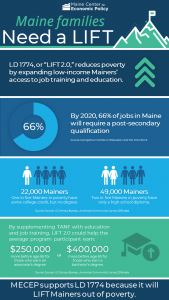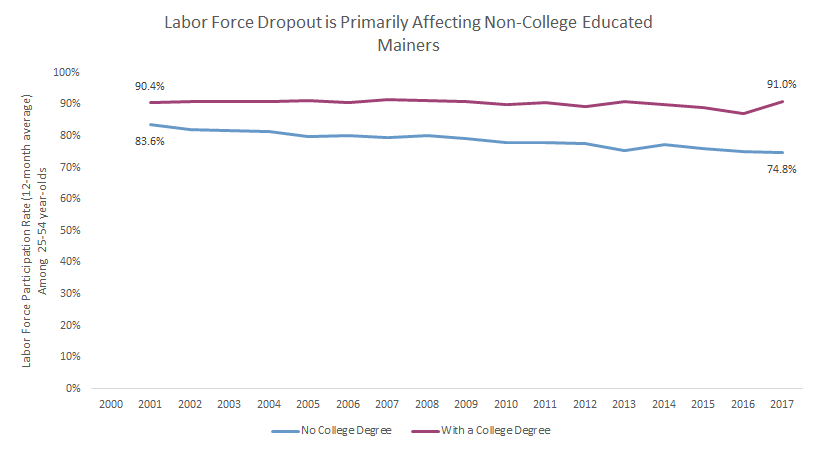On Tuesday, Maine’s Speaker of the House, Sara Gideon, presented a bill to reduce poverty by expanding access to education and job training. The legislation will lift Mainers out of poverty and increase participants’ lifetime earnings — the knock-on effect of which will support Maine’s economy at large.
The bill — LD 1774, “An Act to Reduce Child Poverty by Leveraging Investments in Families for Tomorrow” — is known more colloquially as “LIFT 2.0,” for its relation to anti-poverty legislation included in last year’s biennial budget. Whereas the first LIFT bill addressed the immediate needs of families in crisis, such as ensuring basics such as housing and heat, LIFT 2.0 will help the state meet a goal we all share: providing a pathway out of poverty for low-income Mainers.
LIFT 2.0 makes it easier for low-income students to complete their studies by boosting existing anti-poverty programs: Temporary Assistance for Needy Families and the Supplemental Nutrition Assistance Program, known by many in the public as “food stamps.” The bill’s enactment will provide low-income Mainers with children who qualify for TANF and SNAP with job training and educational resources.
The Parents as Scholars Working Families Program, as established by the bill, would provide non-cash financial aid to low-income parents of minor children who are pursuing a post-secondary degree or credential in a field with good prospects for employment (as determined by the Department of Labor).
The bill’s second initiative, The Food Supplement Employment and Training Program, would create partnerships between the state and third-party educational institutions or community organizations that provide education and job training to SNAP participants.
Education is perhaps the single most effective tool in fighting poverty, and LIFT 2.0 makes it easier for low-income parents to enroll in college and earn a degree. In addition to helping parents and children, the bill will also help Maine businesses and our economy by strengthening our workforce and readying Maine workers for today’s job market.
Low-income students face unique challenges in completing their studies
Several years ago, I was a member of staff and adjunct professor at the University of Southern Maine’s Lewiston-Auburn College. A large part of the student body there has much in common with other Mainers this bill will help.

Nearly every student I met was a nontraditional student. Many were parents, and most were struggling to make ends meet. Some were trying to balance work, family and school — a nearly impossible task. As a lecturer, there would rarely be a week when I didn’t have a student in distress. Someone would have to miss class because their boss wouldn’t let them change shifts and they couldn’t afford to lose the income. I had a work-study student who would bring her grandchild with her some days because she couldn’t afford child care. Her daughter was also a student at the college. I spoke to a veteran of the war in Afghanistan, a father who broke down into tears because he was going to be late for an assignment. His girlfriend had assaulted him, and he was living with his kid in a motel.
I share these stories to show just how close many low-income adult students are to crisis. Every graduation ceremony at the college was like a victory celebration. These students persisted against all kinds of challenges to get their degrees and build a better life for themselves and their families.
But many don’t make it to graduation. So many students find their paths to a diploma or certificate interrupted by crisis. Those who are working their way through can sometimes only afford the expense and time for one class a semester. At that rate, it takes 10 years to complete a bachelor’s degree[1]. We know that the more classes a student can take in a semester, the more likely they are to complete their degree[2]. This bill would relieve a lot of the stress faced by students like those I taught. It would mean less time worrying about how to put food on the table or arrange child care, and more time to go to class and do homework.
Education and job training lift people out of poverty by increasing lifetime earnings
When students earn a degree, their lifetime earnings potential increases greatly. Even for the average TANF recipient, at age 35,[3] an education boosts lifetime earnings dramatically. A 35-year-old Maine woman with a high school education who earns an associate degree will earn, on average, $250,000 more before she turns 65 than she would have without the degree. For someone who earns a bachelor’s degree, those extra earnings rise to $400,000[4]. Extra earnings mean a decreased likelihood of falling back into poverty and better life chances for their children. It means greater access to health care and, ultimately, a better quality of life.
Those higher earnings will also save the state money and strengthen our overall economy. A modest investment of public money now be repaid with thousands of dollars in additional tax revenue. What’s more, by investing TANF and SNAP funds in education, we make it less likely that individuals will need state help again in the future. We also improve their chances of a retirement with dignity. That’s especially important for women, who are more likely to reach retirement age without enough Social Security contributions for a secure retirement. Helping parents to complete college also provides a positive role model for their children, making it more likely that they will get a degree themselves. This is an investment that will keep paying dividends for generations.
More education also equips these Mainers for the future of work. An estimated 66% of Maine jobs will require a post-secondary qualification by 2020. A college education will give Mainers the ability to access these jobs. It will also give employers more workers to fill these positions.
LIFT 2.0 addresses Maine’s workforce dilemma
We must do everything we can to improve not just the quality, but also the quantity of our workforce. Since 2001, the share of prime-age Mainers (those between the ages of 25 and 54) in our workforce has been dropping steadily. MECEP estimates about 22,000 more people would be in the labor force if prime-age Mainers were participating at the same rate today as they were in 2001.[5]
To put that in perspective, 20,000 Mainers were looking for work and officially counted as “unemployed” in December 2017[6]. If those missing workers were included in the official unemployment rate, it would be nearly twice as high. This labor force dropout has a complex set of causes, but we know that the drop out is especially high among those without a college degree. Prime-age labor force participation among Mainers without a college degree has dropped from 84% to 75% since 2001, accounting for nearly all of those 20,000 missing Mainers[7].

Source: MECEP analysis of US Census Bureau, Current Population Survey, 2001-2017 data.
Conclusion
Enactment of LIFT 2.0 will transform our safety net with a revived focus on education and routes out of poverty. It will transform the lives of Maine families by helping them reach their full potential and build better lives. It will improve our state’s workforce, and in doing so, boost our economy and help our businesses. For all those reasons, MECEP supports enactment of LD 1774.
Notes
[1] Based on a student taking one 3-credit class in each of the four semesters each school year (including winter and summer semesters).
[2] Complete College America data.
[3] MECEP analysis of US Census Bureau, American Community Survey, 2016 data
[4] MECEP analysis of US Census Bureau, American Community Survey, 2016 data. Assumes a 2-year completion for an associate degree and four years for a bachelor’s degree.
[5] MECEP analysis of US Census Bureau, Current Population Survey, 2001-2017 data.
[6] Maine Department of Labor data.
[7] MECEP analysis of US Census Bureau, Current Population Survey, 2001-2017 data.



